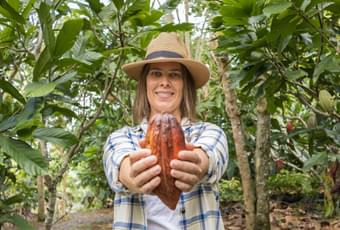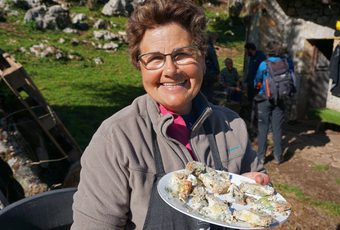Blog
Catalonia's best traditional festivals and how you can experience them
Whether it’s the harmony of an anthem on Catalan Day, the exchange of roses on St George’s Day, or the smoky chaos of an onion-eating contest, these festivals are more than just cultural highlights. For local communities, they’re a way to honour identity, history, or just simply have fun.
For travelers, they offer something just as valuable - a chance to connect with a place and its people on a far more personal level.
To further explore my Catalan roots, I got to know three of the region’s most cherished (and perhaps odd) traditions to see what it means to be involved in these festivals, both through the lens of a local and a curious traveler. What I found was a deep sense of pride, community and flawless memories that I hope encourages other cultural travelers to discover more on their next trip.
1. Gran Festa de la Calçotada
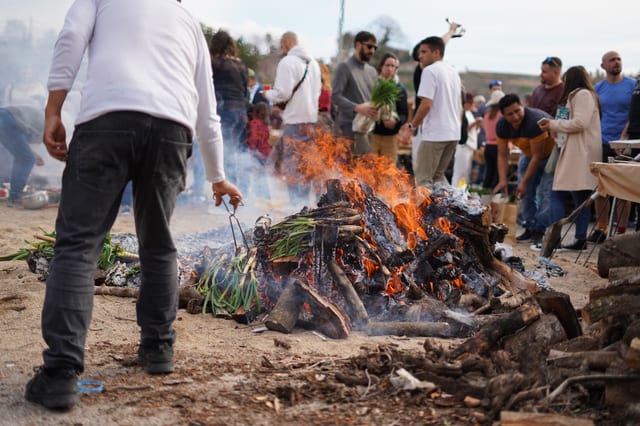
Marking the beginning of the calçot season, Gran Festa de la Calçotada hosts a spectacular feast for the community of Valls. Larger and milder than the typical green onion, this native vegetable becomes the centre of attention during Catalonia’s most unique gastronomy festival.
Where it all happens
The event kicks off every year on the last Sunday of January, when friends and families come together to the mother home of all calçots. The charming town of Valls is just a 30-minute drive from Tarragona or 1.5 hours from Barcelona, off the Costa Daurada.
After parking up on the side streets, head over to the Plaça del Blat in the centre of Valls. This is where you’ll find the eating contest. If you’d rather not watch the scoffing of the veg for the full half-hour show, then it’s a great time to wander around and try out the homemade salsas from the markets. The most common being the romesco sauce, made of roasted red peppers, tomatoes, almonds, garlic, bread, olive oil and vinegar.
If you’re feeling curious enough, then why not try out the romesco-flavoured ice cream? We won’t be offended if you’d rather not.
Following the crowds, make your way to the ‘zona de degustación’ where lines of tasting tables offer you the chance to join in and feast amongst the locals.
Prepare to get messy
You might be wondering what to expect at this bizarre event. Well, prepare for a lot of smoke, a lot of salsa and hell of a lot of calçots.
At the tasting zone, you can buy a calçotada kit from the counter, superbly prepared with a bunch of the long greens and a romesco salsa to go with it. Handing over your calçots to the fire-masters, they’ll throw them into the smoke, cooking them for your feast.
For tips on how to eat these complicated onions, hold them from the top and peel down the charred layer. Get a big dollop of the salsa on there and hold it up above the head and into the mouth.
Oh, there’s also a bib in the bag too. You may need that.
In the plaça, contestants compete to eat the most calçots within a time limit. Thirteen-time winner Adrià Wegrzyn broke a world record in 2025’s competition by eating 195 calçots in 45 minutes. He’s practically a celebrity in Valls. If you manage to beat Adrià’s record, we can make you a big celebrity in the Pura office.
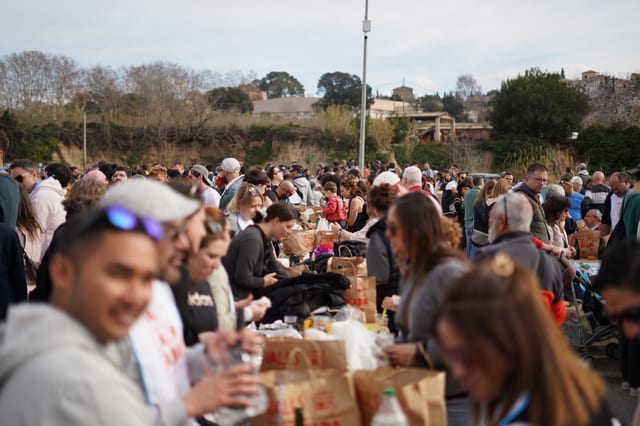
Tips for travelers
1. Be willing to get a messy – with the smokey fires and lack of cutlery it’s best not to wear your finest white linen for today.
2. Although not a huge festival, it’s a popular occasion. Arrive early to beat the queues and claim your spot with a picnic and chair. The event usually starts at 11am (early for a Sunday in Spain) but it’s worth heading over an hour or so even earlier.
3. Don’t be fooled by the hagglers offering ten euro for a parking spot. The car parks might be full but there’s plenty on-street parking to look out for.
4. If you can’t make it to the Gran Festa, it’s well worth checking with your local tourist board if there’s any smaller calçotada’s in the area running during the season from January – March.
Whether or not you're ready to scoff down 3kg of green onions, this is a uniquely Catalan experience that’s all about fun, food and friendly chaos. The people of the town are evidently very proud of the event, preparing for months beforehand. Although a precious tradition in Catalonia, they also recognise it is a slightly odd occasion and everyone’s just there to have fun.
2. La Diada Nacional de Catalunya (Catalan National Day)
Commemorating the 1714 siege of Barcelona that marked the loss of Catalan institutions and autonomy, September 11th becomes a day of cultural pride and political expression all over the region.
What once was a suppressed identity, La Diada is now celebrated through anthems, human towers, flag parading and an empowering sense of community.
A visitor’s perspective
Used to stumbling across local festivals in even the remotest parts of Spain, I look towards our Product Lead, Chris Bladon, who tells me about his own experience at the event and the lasting impression it left on him.
Planning ahead not to miss the spectacles of Catalonia’s most traditional elements, Chris told me “I knew the festival was coming and that the castellers - the region's famous human towers - were doing the rounds too. So, I took our little gang down to the charming seaside town of Sitges”.
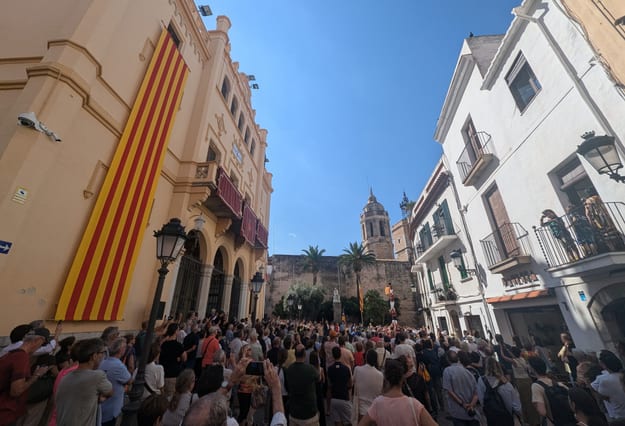
Chris and his family were welcomed with an unbreakable chanting of Els Segadors - Catalonia's once-rebellious national anthem. “We were the only outsiders” he said, “mere flies on the perfectly whitewashed walls, feeling tiny below the impressively oversized yellow and red Senyera flags”. Stunned with a huge sense of unity, Chris justifies how you don't need to understand the lyrics to feel their pride.
The human tower takes shape
Gathering at the base of the tower, participants clamber up the backs and shoulders of one another. They latch arms to solidify the casteller before the smallest, and bravest of them all signals at the summit.
A couple of years ago, a group of castellers broke the record for the highest tower, reaching 10 tiers in the square of nearby Vilafranca del Penedés. On the day Chris visited, that record was never in danger: "turns out it was the kids' team… and they managed about three stories - so more of a small, but impressive, pillar".
Despite the size, it’s still incredible to see the power it takes to balance the stack. The crowd acknowledges the efforts and cracks a roar of enthusiasm as the youngster unveils the Catalan flag.
Where it all happens
Sitges isn’t the only place where Catalan Day is celebrated. Wherever you are in the region, it’s likely your closest town or city will be waving the flags. Some of the largest events take place in Tarragona, Barcelona, Girona and Reus. If you’re hoping for something with smaller crowds, it’s worth checking with the local tourist board to see what they’re doing for Catalan Day in the local area.
3. Sant Jordi (St George’s day)
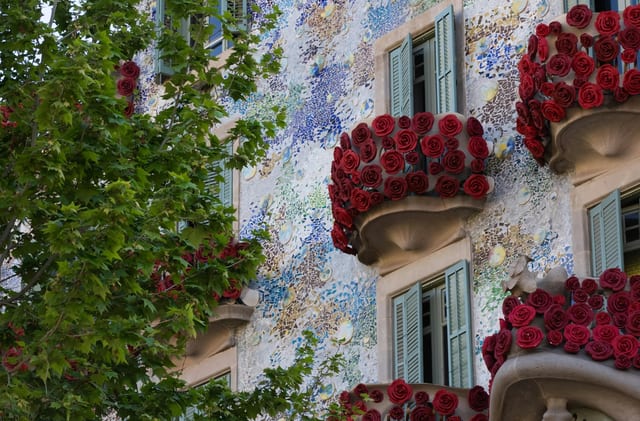
As Catalonia’s most charming festival, Sant Jordi celebrates romance and literature in a slightly more lovey-dovey way than England’s morris dancing and sword fighting. Every year on April 23rd classic books and bright red roses are exchanged in a heartfelt show of love between crushes and couples across the region. It all sounds a bit too cheesy for me, but having heard about this one a lot, I’m willing to find out what more there is to it.
The Legend of Sant Jordi
Catalan legend commemorates this day in honour of St George, who boldly slayed a dragon to save the king’s daughter. Red roses spread from the ground where the blood of the dragon spilt across the floor, representing his bravery and loyalty towards the princess. Reflecting this devotion, it's custom that the gentlemen gift a rose to their love - and if lucky, they might receive a book in return.
However, the gifting of the books wasn’t always part of the tradition. Over the years, the ritual was added to mark the death of Spain’s most celebrated author, Miguel de Cervantes. Supposedly, Cervantes died the same day as Shakespeare, hence April 23rd becoming well established as International Book Day.
Exploring past the legends and into more recent history of this tradition, I take a look at my own Spanish roots to determine what this day of sonnets and flowers means to the Catalan community, acknowledging that it’s not just Cupid doing all the hard work.
Memories of a local
I turned to my mum for this one. She’s always banging on about her childhood memories of this day. Pulling out black and white photos of her aunts, uncles, grandparents who used to celebrate close to their home in Barcelona. I figured it was time to put her memories into writing.
“When I was a kid, my parents would take us to the stalls where my grandma sold roses.” She tells me more about Abuela Antònia, “she was widowed with ten children but with the help of her neighbours, she still managed to be a florist for her entire life… Sant Jordi was particularly special as our entire family came together to help her and celebrate the day."
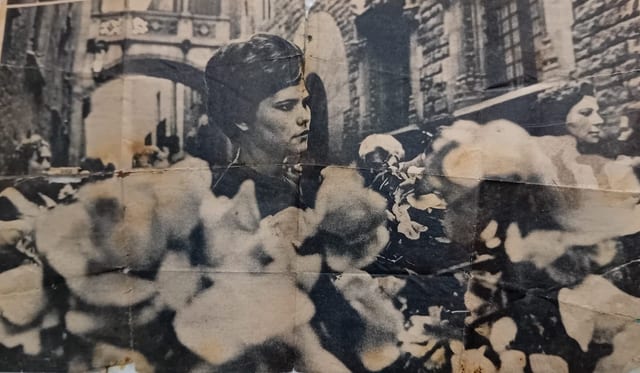
“Sant Jordi was one of the most beautiful things to happen in my childhood.” She continues, “as kids, me and my cousins would meet to watch the puppet shows, giggling at the characters as they comically performed traditional stories… It’s something I’ll remember forever”.
Getting this magical glimpse of history reminds us how important keeping traditions can be towards making memories and connecting families. It’s no longer just a Valentine’s affair but an excuse for the community to come together.
Where it all happens
During my great-grandmother’s time, the heart of the celebration took place in the courtyard of the Generalitat - Catalonia’s governmental building in the Gothic Quarter of Barcelona. “Only the oldest florists got to have stalls there. Everyone else covered the streets around the building”.
Nowadays, the main stalls run along Barcelona’s busy street of La Rambla and surrounding corners – it’s hard not to miss the festivities as it takes over the city.
What it means to be part of Sant Jordi
Whether it’s a romantic exchange of gifts, families working side by side, or strangers brought together in the buzz of the streets, there’s something deeply meaningful about how Catalonia celebrates this day. Through stories passed down, you realise it’s a tradition that holds so much more than meets the eye. It’s history, culture, love, and community – all bunched up like a beautiful bouquet of flowers (ignoring the fact that they wilt at the end).
Final thoughts
Learning more about Catalonia’s festivals, it’s clear these are beloved traditions. Local events, run by locals, not affectations for tourists. Just as importantly, they’re not tripling the price of pints like they do here in the UK.
It’s about being present in the rhythm of local life - feeling the emotion in a song you’ve never heard before, tasting something made with generations of care, and standing shoulder to shoulder with people who are celebrating who they are. These aren’t just events on a calendar; they’re expressions of pride, memory, and community.
You don’t need to understand every word or custom to appreciate what’s happening. Just being there, joining in with an open mind, supports the tradition and shows you the depths of the culture. And if you're lucky, you’ll leave not only with a better sense of Catalonia, but with an appreciation of what it means to keep tradition alive.

Catalonia Signature Drive
-
$4,200 pp
- 14 days

Catalonia's Volcanic Trails & Coastal Charms
-
$3,000 pp
- 10 days

